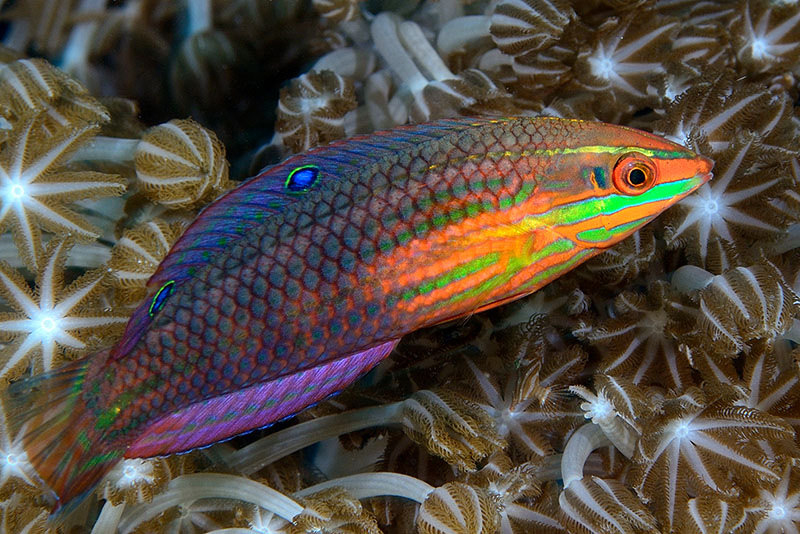- Classification
- ACTINOPTERYGII
- PERCIFORMES
- LABRIDAE
- Halichoeres
- biocellatus
False-eyed Wrasse, Halichoeres biocellatus Schultz 1960
Other Names: Biocellated Wrasse, Red-lined Wrasse, Twospot Wrasse

A female False-eyed Wrasse, Halichoeres biocellatus, at North Rinca Island, Indonesia. Source: zsispeo / Flickr. License: CC BY Attribution-Noncommercial-ShareAlike
Summary:
The False-eyed Wrasse can be identified by the small green spot or mark behind the eye, and broad red submarginal band on the caudal fin.
Males (terminal phase) are generally greenish-brown with orange and green stripes on the head that become greenish-brown bands on the rear of the body.
Females (intermediate phase) are more colourful with pink, blue, and purple stripes on the body, and a pair of ocelli on the dorsal fin.
Juveniles (initial phase) have a series of orange, green and white stripes on the sides, a pair of ocelli on the dorsal fin, and a small black spot on the upper part of the caudal-fin base.
Males (terminal phase) are generally greenish-brown with orange and green stripes on the head that become greenish-brown bands on the rear of the body.
Females (intermediate phase) are more colourful with pink, blue, and purple stripes on the body, and a pair of ocelli on the dorsal fin.
Juveniles (initial phase) have a series of orange, green and white stripes on the sides, a pair of ocelli on the dorsal fin, and a small black spot on the upper part of the caudal-fin base.
Cite this page as:
Bray, D.J. & Thompson, A. 2020, Halichoeres biocellatus in Fishes of Australia, accessed 01 Jul 2025, https://fishesofaustralia.net.au/home/species/2289
False-eyed Wrasse, Halichoeres biocellatus Schultz 1960
More Info
|
Distribution |
Cape Cuvier to the Murion Islands, and offshore reefs of north Western Australia, and the far northern Great Barrier Reef, Queensland, and reefs in the Coral Sea, to at least Seal Rocks, New South Wales, with juveniles to Montague Island. Elsewhere the species occurs in the tropical, east-Indo-west-central Pacific. Inhabits seaward reefs, including reef crests and slopes, usually in areas of mixed coral, rocky or rubble-algae substrates with sand patches. |
|
Fisheries |
Traded in the aquarium industry. |
|
Species Citation |
Halichoeres biocellatus Schultz 1960, Bull. U.S. Natl Mus. 202(2): 233, fig. 104. Type locality: Lagoon at Arji Island, Bikini Atoll, western Pacific, depth 20-40 feet. |
|
Author |
Bray, D.J. & Thompson, A. 2020 |
|
Resources |
False-eyed Wrasse, Halichoeres biocellatus Schultz 1960
References
Allen, G.R. 1993. Fishes of Ashmore Reef and Cartier Island. Records of the Western Australian Museum, Supplement 44: 67-91
Allen, G.R. 1997. Marine Fishes of Tropical Australia and South-east Asia. Perth : Western Australian Museum 292 pp. 106 pls.
Allen, G.R & Erdmann, M.V. 2012. Reef Fishes of the East Indies. Volume II. Tropical Reef Research, Perth, Australia.
Russell, B.C. 1983. Annotated checklist of the coral reef fishes in the Capricorn-Bunker group, Great Barrier Reef, Australia. Great Barrier Reef Marine Park Authority. Special Publication Series 1: 1-184 figs 1-2
Russell, B.C., Larson, H.K., Hutchins, J.B. & Allen, G.R. 2005. Reef fishes of the Sahul Shelf. The Beagle, Records of the Museums and Art Galleries of the Northern Territory Supplement 1 2005: 83-105
Schultz, L.P. 1960. Family Labridae. pp. 121-238, figs 94-104, pls 92-107 in Schultz, L.P., Chapman, W.M., Lachner, E.A. & Woods, L.P. (eds). Fishes of the Marshall and Marianas Islands. Vol. 2. Families Mullidae through Stromateidae. Bulletin of the United States National Museum 202(2): 1-438, figs 91-132, pls 75-123
Westneat, M.W. 2001. Labridae. pp. 3381-3467 in Carpenter, K.E. & Niem, T.H. (eds). The Living Marine Resources of the Western Central Pacific. FAO Species Identification Guide for Fisheries Purposes. Rome : FAO Vol. 6 pp. 3381-4218.








